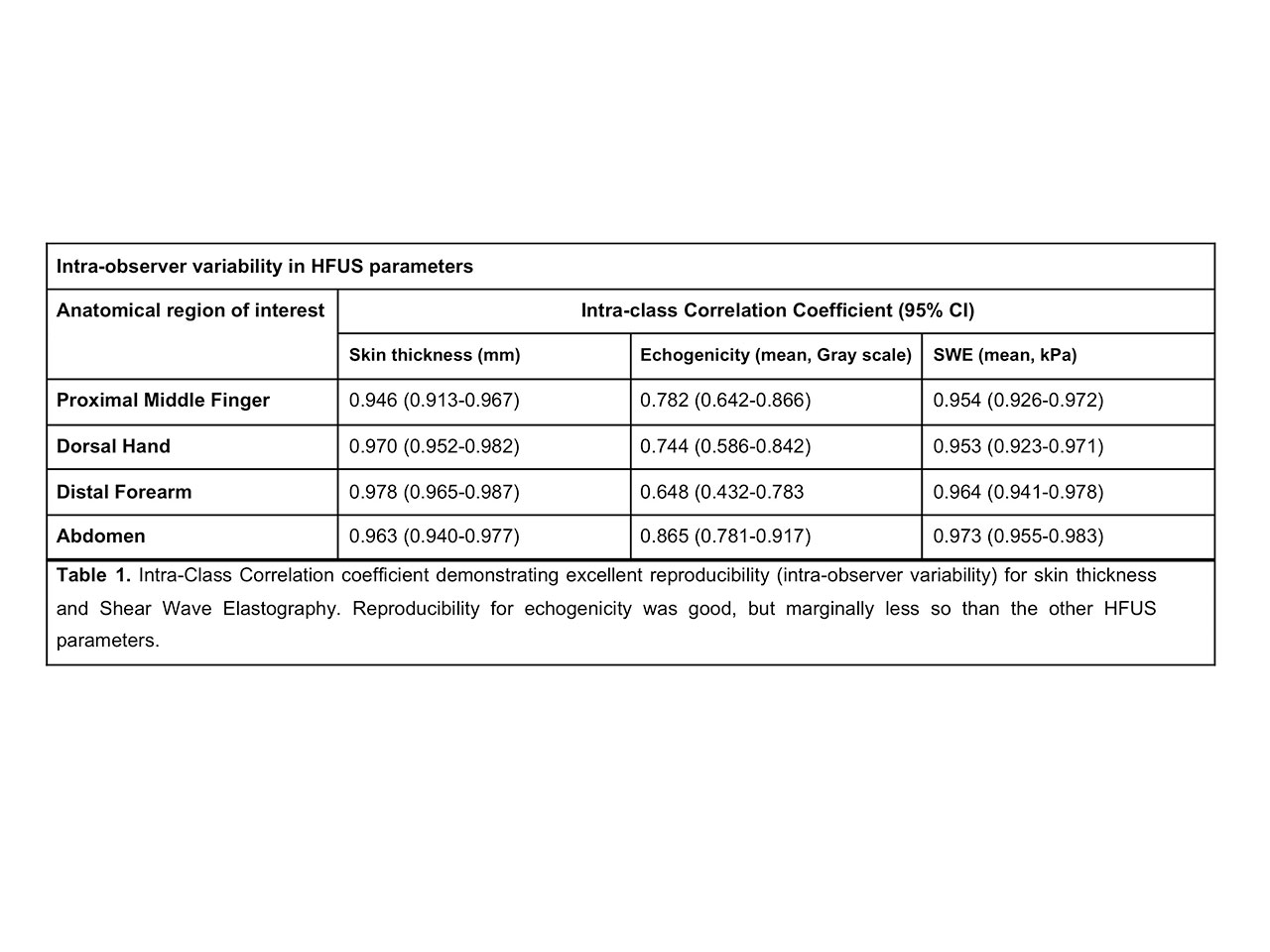Session Information
Session Type: Poster Session (Monday)
Session Time: 9:00AM-11:00AM
Background/Purpose: There have been a number of recent negative clinical trials of SSc utilising the modified Rodnan Skin Score. High Frequency Ultrasound (HFUS) allows objective quantitative and qualitative assessment of dermal pathology and could be a useful surrogate measure of skin involvement in Systemic sclerosis (SSc). No previous studies have examined the convergent validity between HFUS features and dermal collagen in SSc. The repeatability of HFUS warrants further assessment before this method can be accepted in clinical practice. This study aims to assess the repeatability and convergent validity of HFUS parameters with dermal collagen deposition in SSc.
Methods: Fifty-three patients with SSc meeting ACR/EULAR 2013 criteria and 15 healthy controls (HC) underwent HFUS assessment of skin thickness (ST), echogenicity (as a reflection of cutaneous oedema) and Shear Wave Elastography (demonstrating skin stiffness, SWE) at the middle finger, hand, distal forearm and abdomen. Ten SSc patients and 10 HC underwent skin biopsies taken from the distal forearm. Dermal collagen was determined using Masson’s Trichrome stain.
Results: Strong positive correlations were found between dermal collagen quantification and both ST (Spearman’s rank correlation coefficient, ρ = +0.697, p=0.025) and SWE (ρ = +0.709, p=0.022) at the forearm in SSc, but not with echogenicity. Multiple linear regression analysis confirmed ST and SWE as significant predictors of localised skin collagen deposition in SSc (R2 = 0.876). ST and SWE were highly reproducible across all 4 regions of interest for the combined cohort (SSc and HC combined) with Intra-class Correlation Coefficients (ICC) of 0.946-0.978 and 0.953-0.973 respectively (Table 1). Echogenicity reproducibility was good, but weaker than ST and SWE (ICC 0.648-0.865).
Conclusion: We have demonstrated for the first time that ST and SWE on HFUS reflect collagen deposition in affected SSc skin. However, whilst low echogenicity is felt to reflect cutaneous oedema, increasing echogenicity does not accurately reflect fibrosis. HFUS parameters were highly reproducible although notably more so for ST and SWE than echogenicity. Our findings strongly support the use of ST and SWE in particular as a surrogate marker for skin fibrosis in clinical trials.
To cite this abstract in AMA style:
Flower V, Barratt S, Hart D, Mackenzie A, Shipley J, Ward S, Pauling J. Assessment of the Repeatability and Convergent Validity with Dermal Collagen of High Frequency Ultrasound in Systemic Sclerosis [abstract]. Arthritis Rheumatol. 2019; 71 (suppl 10). https://acrabstracts.org/abstract/assessment-of-the-repeatability-and-convergent-validity-with-dermal-collagen-of-high-frequency-ultrasound-in-systemic-sclerosis/. Accessed .« Back to 2019 ACR/ARP Annual Meeting
ACR Meeting Abstracts - https://acrabstracts.org/abstract/assessment-of-the-repeatability-and-convergent-validity-with-dermal-collagen-of-high-frequency-ultrasound-in-systemic-sclerosis/

